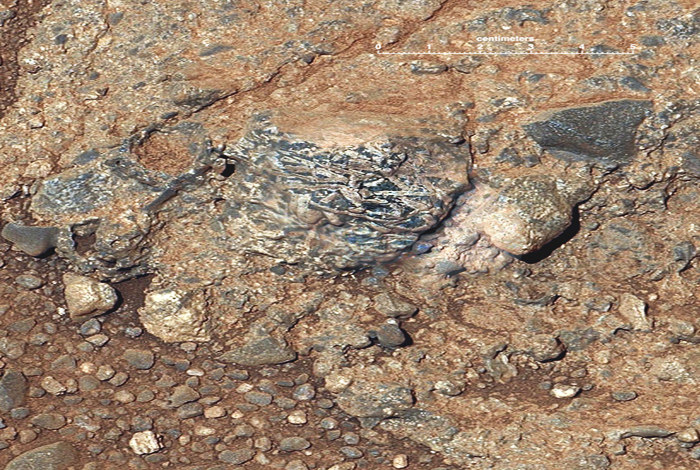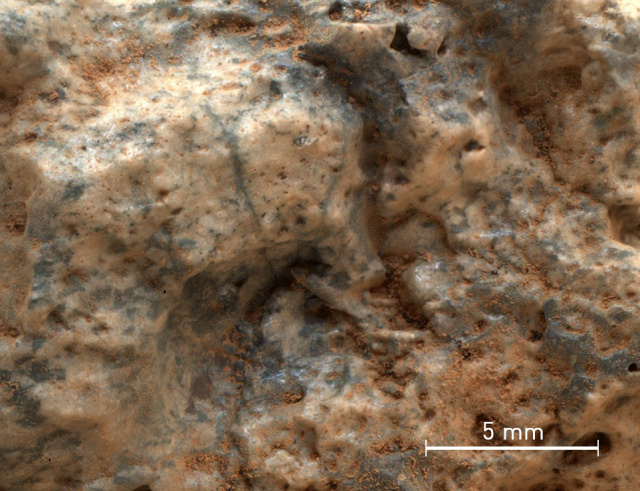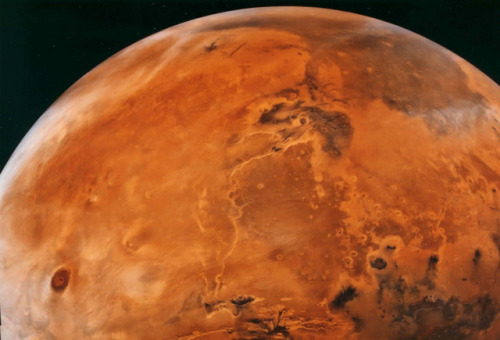
The Curiosity rover, still roaming in Gale crater, has discovered the first evidence for a potential ancient “continental crust” on Mars, which would be a very significant finding regarding Mars’ early history and to what degree it may have paralleled Earth’s.
The new results, announced July 13, come from the ChemCam instrument on the rover, which uses its laser to identify the mineralogical and chemical makeup of rocks, and they are similar to what is found in granitic continental crust rocks on Earth.
According to Roger Wiens of Los Alamos National Laboratory and lead scientist on the ChemCam instrument: “Along the rover’s path we have seen some beautiful rocks with large, bright crystals, quite unexpected on Mars. As a general rule, light-colored crystals are lower density, and these are abundant in igneous rocks that make up the Earth’s continents.”

The findings are in contrast to what has usually been seen elsewhere on the planet before, which is mainly a basaltic composition of rocks. Gale crater, however, still contains pieces of igneous rocks, which were analyzed by ChemCam. Twenty-two such rock fragments were studied via Curiosity by U.S. and French scientists, led by Violaine Sautter of the National Museum of Natural History in Paris, who determined that the pale-colored rocks are rich in feldspar, along with some possible quartz. They are surprisingly similar to rocks in Earth’s granitic continental crust. In particular, they strongly resemble a terrestrial a rock type known as TTG (Tonalite-Trondhjemite-Granodiorite), which are rocks that predominated in the terrestrial continental crust in the Archean era more than 2.5 billion years ago. Some of the rocks contain silicon oxides and alkalis with fine-grained to crystalline textures, while others are coarser-grained, like quartz diorite and granodiorite.
In general, there are three rock types found; some had large crystals in them, others had microscopic crystals, and still others with both large and microscopic crystals, which may indicate magma which cooled slowly before erupting. The ones with the large crystals closely resemble the granodiorite type of granite.
The new results were just published in Nature Geoscience.
Most of Mars’ rocks have been produced through volcanism, so the discovery is a surprising and exciting one, and suggests that Mars’ early history was more similar to Earth’s than previously thought. These granite-like rocks are similar to ones in Earth’s ancient continental crust, quite different from the basalt which composes the seafloor. As also noted by the researchers, the rocks “challenge the simple idea of continuous cooling of the Martian mantle over geologic time, pointing to more complex global or local variation in mantle temperature.”
The walls of Gale crater provide a natural geological cut-away view 1-2 miles down into the crust, ideally suited for a rover to study; some of the rocks found would not be easily visible to orbiting satellites.

It was previously thought that the Earth was the only planet in our Solar System with a continental crust, since it typically takes a long time for lighter rocks to rise to the surface and become the continental crust. Earth’s crust is divided into tectonic plates, which move over the softer mantle below. The plates which make up the oceanic crust are thinner, darker, and heavier, while the continental crust plates are thicker, lighter-colored, and lighter in weight.
As noted by the researchers in the paper, “We conclude that silica-rich magmatic rocks may constitute a significant fraction of ancient Martian crust and may be analogous to the earliest continental crust on Earth.”
“This tells us that Mars is more Earth-like than we ever thought,” added Wiens. “These are rocks with large feldspar crystals and potentially excess silica, so Mars does not just consist of dense dark looking rocks, but also has rocks that really look like they could be on any continent on Earth, and that’s a first on Mars.”
“The conventional wisdom from previous Mars missions has been that Mars is all basaltic like the oceanic crust on Earth, fairly high density, dark-colored, with a lot of mineral called olivine, and that’s what previous rovers found,” said Wiens.
While this isn’t direct evidence for actual plate tectonics on ancient Mars, it does provide evidence for at least the precursors to them.
“There’s a bit of evidence for the precursor to tectonics, because there are magnetic domains that were found in parts of the southern hemisphere on the surface of Mars,” said Wiens. “The planet doesn’t have a magnetic field now, but it suggests that it did have one in the past.”
The findings, combined with many others regarding Mars’ geological history, are helping scientists to better understand the complex history of this fascinating world, and whether it could have supported life.
“So we’re coming a long way in several different areas in piecing together what several billion years ago was a world probably much more like Earth than we ever imagined,” said Wiens. “And that’s pretty exciting because Earth is this oasis of life now, and we wonder what Mars was like at one point in time.”
Curiosity is continuing to explore its environs in Gale crater, after having just passed through the period of solar conjunction when communications were necessarily halted for a couple of weeks. It will now continue to move through the valleys ahead and into the foothills of Mount Sharp, which will provide even greater geological context for new discoveries and learning about Mars’ ancient history in this region.
Be sure to “Like” AmericaSpace on Facebook and follow us on Twitter: @AmericaSpace
Missions » MOM » Missions » MAVEN »




2 Comments
2 Pings & Trackbacks
Pingback:Curiosity finds first evidence for possible 'continental crust' on Mars
Pingback:Curiosity Marks 3rd Anniversary on Mars With Amazing Science Discoveries « AmericaSpace